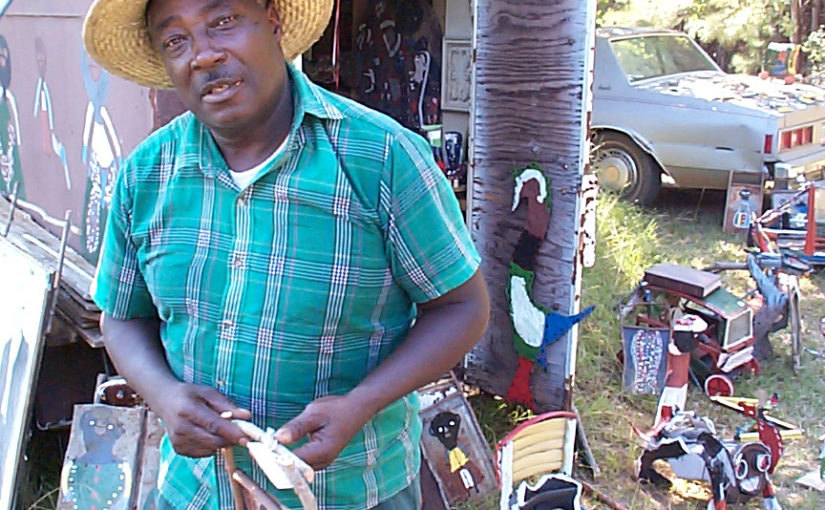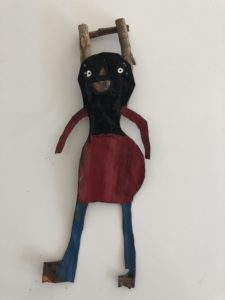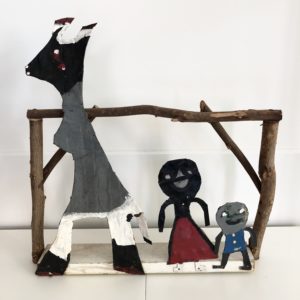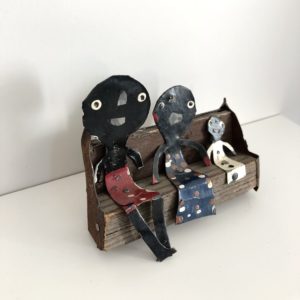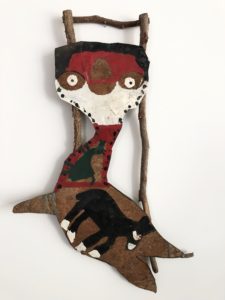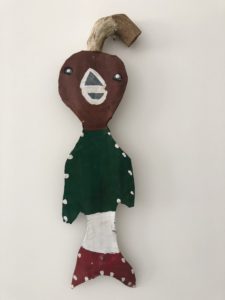1943 – , Alabama
Arriving at Buddy Snipes’ rural southeastern Alabama home, the art decorating his roomy country lot is visible in every direction. We see smiling faces staring up, brightly painted on tin and wood, and creatures of whimsy, fish and “catfish” (tin cutouts, the head of a cat, and the body of a fish) lying on the hoods and trunks of rusted cars, drying in the hot August sun. The three room wood frame house that Buddy Snipes lives in has no indoor plumbing, no running water and is heated by a fireplace and a wood stove. He does have electricity.
 When we asked why he started making art Buddy replied, “I started out makin’ toys for myself and my family. I’ve always been makin’ something out of nothin’.” One of 12 children, Buddy was born in Macon County, Alabama, and 59, or so, years later, he still lives nearby. Buddy was delivered by a midwife and is not positive about his age. “They says I wadn’t no bigger than a co-cola bottle when I was born!” Sickly as a child, he “never went to no doctor ’cause they wasn’t no money to pay ’em with”. Buddy went to school only sporadically for 3 or 4 years before giving it up altogether. He then began making things out of whatever he could find. “Any toys we had, I made them.”
When we asked why he started making art Buddy replied, “I started out makin’ toys for myself and my family. I’ve always been makin’ something out of nothin’.” One of 12 children, Buddy was born in Macon County, Alabama, and 59, or so, years later, he still lives nearby. Buddy was delivered by a midwife and is not positive about his age. “They says I wadn’t no bigger than a co-cola bottle when I was born!” Sickly as a child, he “never went to no doctor ’cause they wasn’t no money to pay ’em with”. Buddy went to school only sporadically for 3 or 4 years before giving it up altogether. He then began making things out of whatever he could find. “Any toys we had, I made them.”
As he grew older, he began to get laboring type jobs that were then still plentiful in rural Alabama. Buddy worked as a pulp wooder, logger, farmhand, dishwasher, and he fixed things for people. He fixed broken furniture, sagging doors and he built fences. “I made wagons and wheelbarrows, too,” he says. He made them out of tree limbs and scrap lumber to sell to his neighbors.
About 15 years ago, he also began to make “things” that he liked. He keeps some of these assemblages around and in his house. They are made from roots, limbs, vines, scrap lumber, signs, tobacco cans, snuff jars, mirrors, horse collars, horseshoes and cold cream jars…whatever he finds that triggers his imagination.
“I sees something,” says Buddy, “and it just comes to me, and I goes and makes it. Everybody has talents; God puts this in my head and I does it.”
Buddy is not at all surprised that his constructions are selling. When it was suggested that he might become famous because of his art, he retorted, “I’m already famous.”
“If a man has got an education,” he says, “he can get a good job. Somebody without any…all the jobs I used to get, they are gone now. So I hafta’ do what I can to survive. I’m just gonna’ keep on making things.” Buddy shows us, pointing to mature pine to opposite pine, where the cotton fields used to be. He has lived here his entire life and has seen the land and its inhabitants go through a lot of change. Depicting people and scenes that have affected Buddy’s life is the inspiration behind his painting, toy making and personal portraits.
That never ending need to “tinker” and to keep happy memories alive by passing along stories through his creations has also been a reliable source of income for Buddy. Not only have people been purchasing Buddy’s art, but also hand crafted wagons and wheelbarrows made of roots, limbs and scrap lumber, cabinets and chairs made out of sticks. Growing up in the A.M.E church, Buddy relives scenes from his childhood in his paintings at functions like “camp meeting”, which were religious gatherings that lasted several days where everyone brought food, often live hogs and chickens, which they killed, cleaned and ate. There was a lot of preaching, but also lots of socializing and visiting.
In the true folk painting tradition, James Buddy Snipes gives us a visual history of daily life and communicates traditional values, allowing us insight to a community, and the actual people and experiences who made up that community.
– Marcus Piña, Garde Rail Gallery

